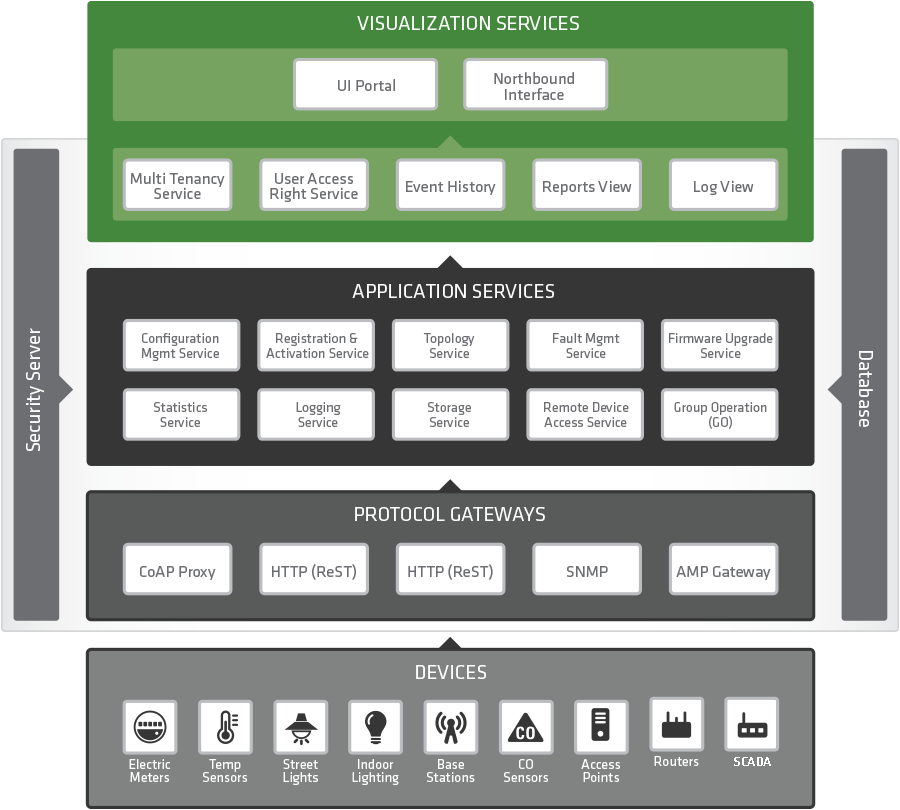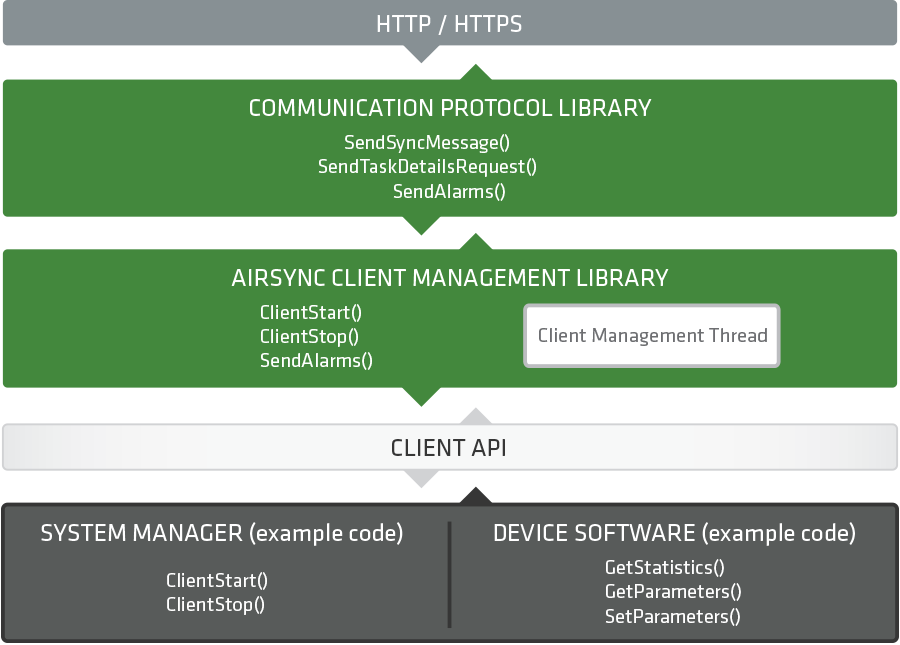Smart devices need smart(er) management
A management solution which is sensitive to the environment in which devices operate rather than one that simply attempts to force traditional management techniques upon the network and devices.
This is what Proximetry builds. Every aspect of our device and network management system, from simple status collection to firmware upgrades and user configuration, takes into consideration the devices’ and network’s constraints, such as:
- Constrained network: low data rate, lossy network, low power
- Constrained power consumption: Battery operated sleepy devices vs. mainline powered devices which are ‘always on’
- Constrained processing with small memory footprint for both RAM and Flash
Built on our AirSync technology, Proximetry offers a fully-integrated management platform that delivers scalable and secure, exception-based device management tuned for today’s innovative, new embedded computing solutions.
Proximetry utilizes a collection of modular application servers that may be tailored to create a custom mix of services specifically targeted for each deployment type. When it comes to deploying (or integrating) our software, it is not an “all or nothing” approach.
Originally designed to manage millions of resource constrained devices in the smart grid, our solution is extendable to support management features to practically any type of device – “The Manager” of the Internet of Things (IOT).
All Proximetry technologies are completely agnostic to the specific device make/model and its method of connectivity (3G, Wi-Fi, IEEE 802.15.4, etc.). Our system can manage devices using CoAP, SNMP, HTTP (REST), AMP –(Proximetry’s proprietary management protocol), or vendor specific proprietary management protocols. Our modular architecture makes it easy to add support for new protocols and new types of devices as required by the market and our partners.
Software to empower new & innovative IoT solutions
Proximetry’s novel approach to device management automates many of the complex network management tasks thus shielding devices’ software developers from complicated bootstrap, and network configuration/association problems.
Our AirSync technology simplifies and automates the five key elements of IoT device management.
Discover
Self-provision
Register
Firmware check
Status
Visualize
Location
Connection(s)
Association
Neighbors
Monitor
Performance
Configuration
Statistics
Enhance
Upgrades
Network change
Adjacent devices
Autonomy
Local events
Thresholds
Data store/flush
Discover
Proximetry supports several methods of device discovery. Automatic discovery, where we ‘look’ for devices using a specific protocol within a specific addressing range, is one approach, however, it can add a significant network load, which may not be acceptable in constrained low bandwidth networks. In these instances, manual device discovery can be used, where devices are explicitly added (bulk list or individual) to the system. Manual registration is also useful when the user would like to pre-provision the devices.
Once a device is discovered, the system automatically registers the device to the appropriate tenant, and pushes configuration or software upgrade to the device if needed.
Visualize
The Proximetry visualization engine allows the user to visualize their devices in map view or topological view. The topological view supports Star, Tree and Mesh views automatically selected in accordance with the specific networking technology and to also visualize the relationship between devices.
Monitor
Proximetry continually monitors the health status of devices, tracks long term performance trends and alerts the user about any anomalies. Any changes to the device health are immediately flagged for user’s attention. On a network-wide basis, the user is presented with KPI of the network assets on the dashboard upon login.
Enhance
Device firmware upgrade and configuration change processes are closely monitored by Proximetry. Devices can be upgraded individually or in mass groups while he system closely monitors the network’s bandwidth resources. Strict traffic shaping of the management application ensures that management does not overtake the network resources thus blocking data flow to and from the device.
The system automatically adjusts to network topology changes by monitoring the adjacent neighbor devices. The adjacent device information is combined with information with many such devices to predict best network configuration and improve performance.
Autonomous
Autonomy is enabled through distributed management decision and control. Some events are best handled by the centralized server, yet some events are best handled locally on the device or a concentrator located near the device. Proximetry technology uniquely supports local event processing where thresholds are monitored and actions may be taken accordingly. This local autonomy also includes local caching of information for both upstream and downstream consumption. Upstream information is cached when the backhaul connection is not available. Downstream caching is used to deliver information in a ‘store and forward’ fashion. This method of information delivery is particularly important for sleeping devices operating within lossy, multi-hop networks.
The Proximetry architecture is shown in the figure below.

Protocol Gateways
The Protocol Gateways perform all the real-time tasks related to managing the devices. The protocol gateways insulate the application servers from the protocol specific behavior, thus allowing for new protocols to be added on-demand and in a short time. Each protocol gateway is scaled independently from all other protocol gateways, and from the application servers. The hardware resources allocated to each protocol gateway can scale with the size of the network and can be increased only when the number of devices managed by this gateway increase.
Application Services
Application Services provide a functional partitioning of the complete management application. The system is designed such that each application is self-contained with minimum overlap of functionality between application services. For example, several applications use topology information to optimize certain management operations (e.g. Firmware Upgrade Server (FUS) and Configuration Management (CM)). These services independently retrieve the topology information from the Topology Service. The Topology Service is the only entity in the system with the knowledge on how to collect and organize the topology information.
Visualization Service
The Visualization Service is the user facing component of the Proximetry environment. Again, designed to insulate the application services from user specific behavior, the Visualization Service allows for quick changes to the UI.
The Visualization Service provides:
- Web-based GUI for the user to manage and provision devices
- User management
- User access rights
- Support for multi-tenant deployments
- Dashboard view of device status
- Group management of devices on scale
- An extensible NBI (North Bound Interface) for interaction with external systems
AirSync Agent SDK
Proximetry’s AirSync Agent software development kit enables IoT solutions developer to quickly integrate our advanced network management solutions into their devices and application. The development kit provides code examples of several small footprint remote client applications (20KB - 4KB) with fully-integrated application level messaging. The AirSync Agent SDK is provided in source code format in C, Java (SE, ME), JavaScript, and Python. The high level software architecture of the Agent SDK is shown in the figure below.

